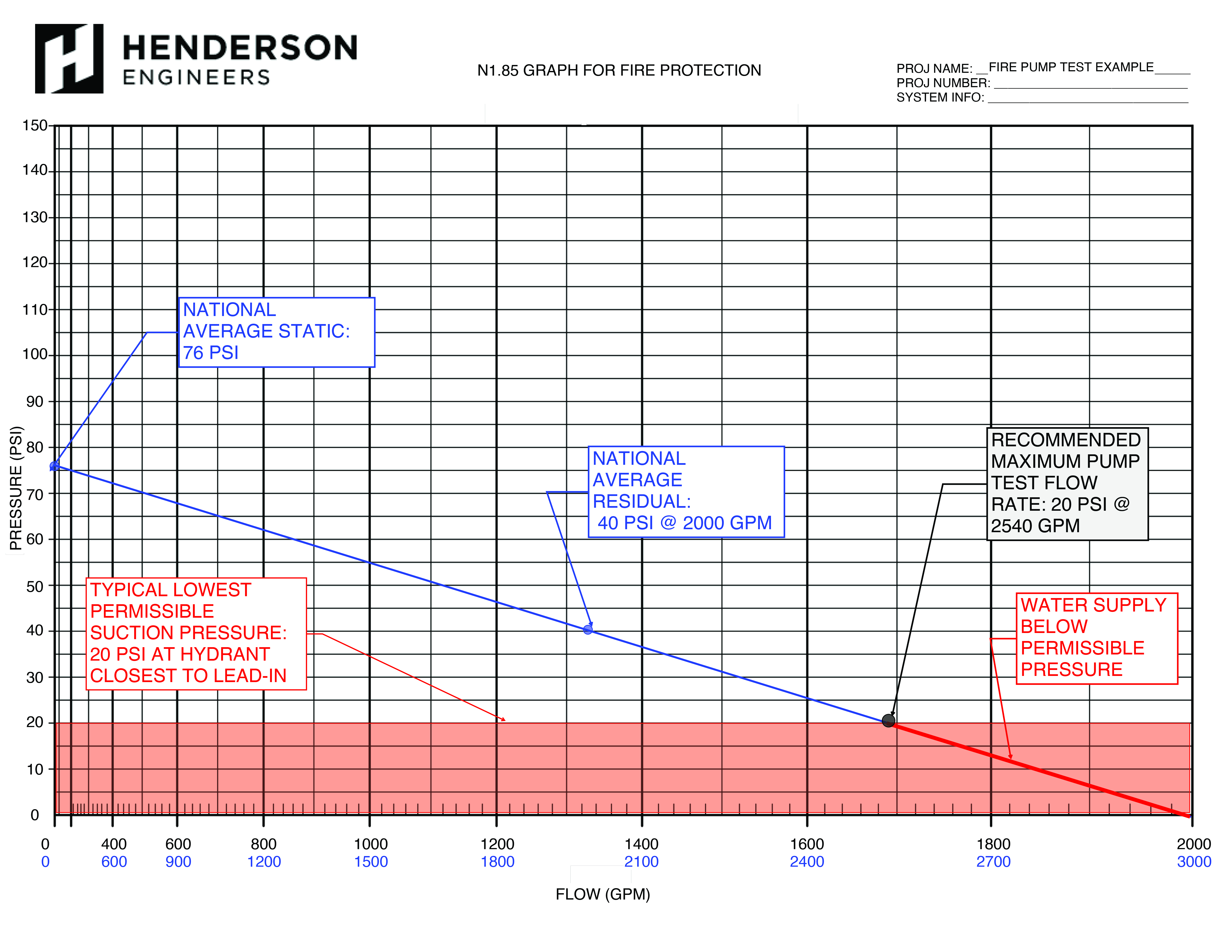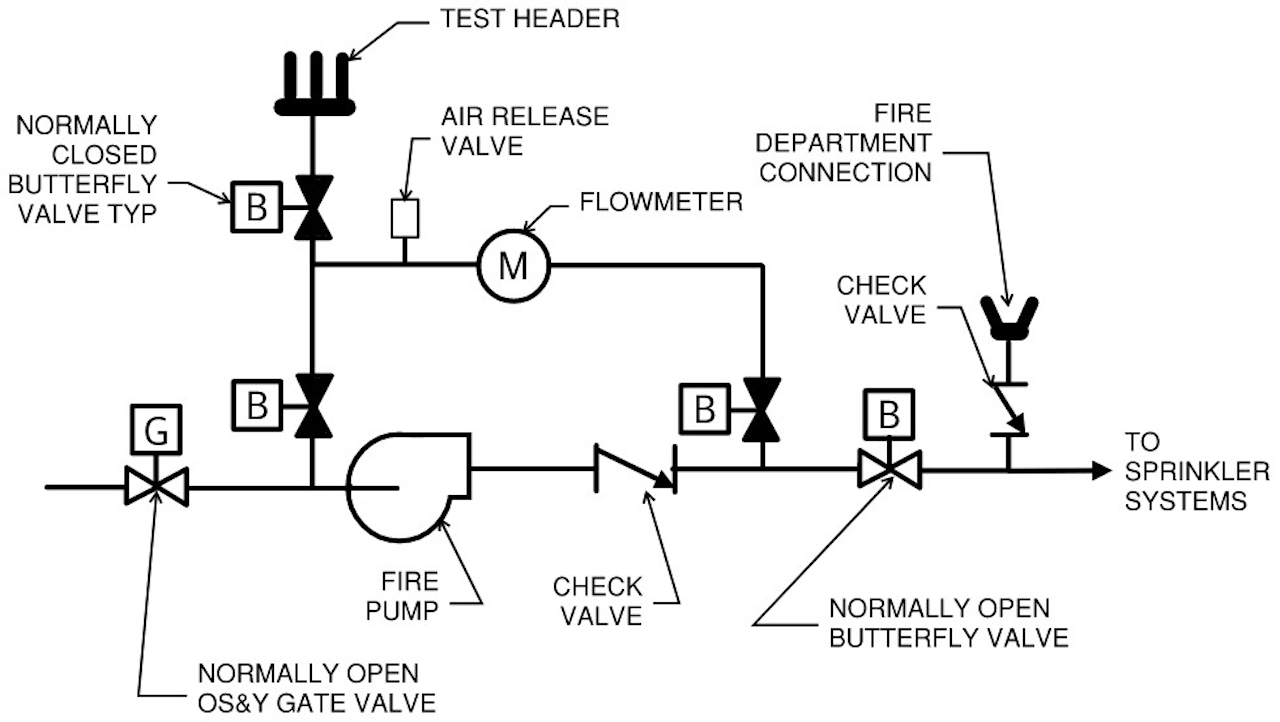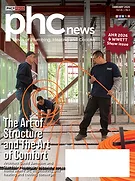Many plumbing and fire protection professionals are familiar with the basic fire pump design standards and requirements stated in NFPA 20, Standard for the Installation of Stationary Pumps for Fire Protection. Most designers understand that a sprinkler or standpipe system’s maximum flow demand cannot exceed 150 percent of a pump’s rated flow rate, and that NFPA requires a fire pump to be operated at 150 percent of its rated flow rate during acceptance testing.
But what happens if the water supply cannot support this demand? Does the pump need to be replaced? Is the test valid? What about tests conducted several years after the pump is installed? Let’s figure it out together!
Pump Design and Testing
Good design practice is to select a fire pump with a rated flow of at least 80 percent of the maximum sprinkler flow rate. For example, given a sprinkler demand of 80 pounds/square inch (psi) at 2,400 gallons/minute (gpm) residual, a fire pump should provide at least 1,920 gpm rated flow. The next largest standard pump capacity is 2,000 gpm, which will be the specified pump size. (Note that pressure selection is dependent on the water supply and does not impact the flow issues discussed in this column.)
During the acceptance test, NFPA 20 requires several flow demands to be tested: no-flow (also called churn or shut-off), 100 percent and 150 percent of the rated capacity. Additional points may be tested, but not less than 50 percent of the flow rate is recommended. Note that variable-speed pumps must have additional flow demands recorded: 0 percent, 25 percent, 50 percent, 75 percent, 100 percent, 125 percent and 150 percent of the rated capacity. Therefore, 150 percent of rated flow is the maximum flow rate expected.
Acceptance testing verifies not only the fire pump capabilities, but also the correct design, installation and condition of the entire water supply network. For example, challenges such as closed valves or obstructions in the site piping will be exposed and noted for additional investigation and correction.
Water Supply Consideration
The 2019 edition of NFPA 20 formalized the definition of lowest permissible suction pressure as the lowest pressure permitted by the authority having jurisdiction (AHJ). Annex language and NFPA commentary inform the reader that many jurisdictions allow 20 psi suction pressure limitation, measured at the hydrant nearest the pump suction or a point upstream of the backflow preventer.
NFPA 20 allows a fire pump’s suction flange pressure as low as 0 psi (or –3 psi where a ground-mounted suction tank is installed). Our example will use the lowest permissible suction pressure of 20 psi at the flow test point.
Unfortunately, public water supplies are not infinite. A study conducted by the author on nearly 150 public water systems around the United States found that the average public water supply is 76 psi static and 40 psi at 2,000 gpm. Ground-mounted water storage tanks are vented to an atmosphere average of 20 psi high static. Referring to the example fire pump, the available pressure at the 3,000 gpm test point (150 percent of rated flow) is -0.3 psi, far less than the 20 psi allowable by most AHJs.
Figure 1 indicates how the water supply cannot support an acceptance test point at 150-percent-rated capacity.

Good news! NFPA 20 has provisions in place for this situation. It states, “where the maximum flow available from the water supply cannot provide a flow of 150 percent of the rated flow of the pump, the fire pump shall be operated at the greater of 100 percent of rated flow or the maximum flow demand of the fire protection system(s) maximum allowable discharge to determine its acceptance.”
Consider our example water supply of 76 psi static pressure and 40 psi at 2,000 gpm residual water supply. Calculating the flow rate at the lowest permissible suction pressure, 20 psi, yields 2,540 gpm. As shown in Figure 1, a pump test flow greater than 2,540 gpm results in unacceptable pressure in the public water supply.
Most importantly, if the maximum sprinkler system flow demand is less than 2,540 gpm, this reduced acceptance test flow rate is acceptable, and the test complies with NFPA 20 requirements.
Testing at 150-Percent-Rated Flow
Good news again! Even if the available water supply does not allow for full 150-percent-rated flow rate testing, it is possible to conduct a fire pump test at the maximum flow. Installing a flowmeter with a water return loop, as shown in Figure 2, allows a centrifugal pump to be exercised to its maximum capacity.

The 2013 edition of NFPA 20 introduced specific requirements for the flowmeter. The flow meter shall be installed upstream of and in series with a full-sized test header. This allows for calibration of the flow meter without physical removal of the device and allows for testing in the exact piping configuration.
Before 2013, flowmeter calibration arrangements might not match those of the actual pump installation, potentially invalidating the results of the flowmeter calibration. Additionally, the flowmeter shall be calibrated no less than once per year to +/- 3 percent accuracy.
Note that positive displacement fire pumps have special requirements for the test return loop.
Water Supply Degradation
The concept of “static” water pressure is a misnomer. Public water supplies are in constant flux due to new construction and water users, pipe breaks and repairs, underground valve operation, pressure plane changes, etc. For these reasons, it is possible for a water supply to degrade over time.
NFPA 25, Inspection, Testing, and Maintenance of Water-Based Fire Protection Systems, includes the same provisions for testing at less than 150 percent of the fire pump capacity. After the initial acceptance test, a calibrated flowmeter may be used for a no-discharge annual pump testing two out of every three years. The full flow test must be conducted once per three years to verify the water supply network, similar to NFPA 20’s acceptance testing requirement.
Remember that variable-speed pumps require additional test points compared to constant-speed pumps, including 125-percent-rated flow. Capture as many of these points as possible up to the maximum flow rate allowed at the lower permissible suction pressure.
This column describes many provisions in the NFPA standards allowing for fire pump testing at less than maximum capacity, as well as a method to allow for a pump to be fully exercised when the water supply cannot support the maximum flow rate.
If the water supply pressure exceeds the lowest permissible suction pressure at the maximum sprinkler demand, the fire protection professional can be confident that the design and installation comply with codes and standards.




